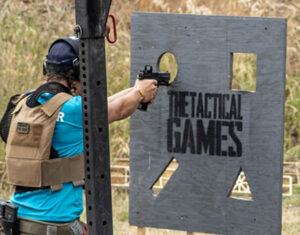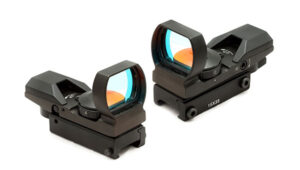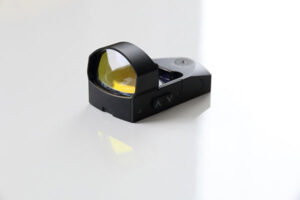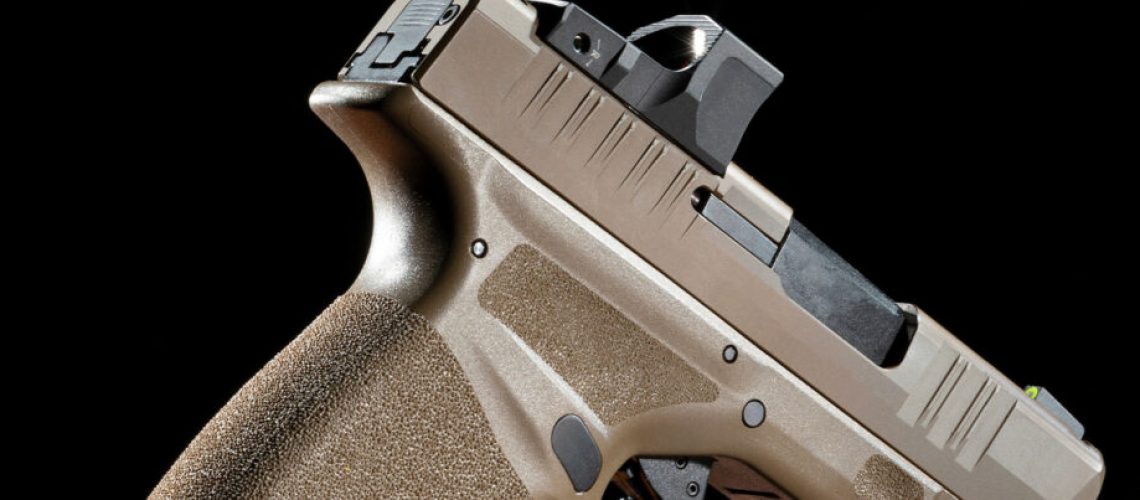HISTORY
The notion of putting a reflex sight on a firearm isn’t new by any stretch. It happened when Sir Howard Grubb first used a reflector or “reflex” sight with a firearm in 1900. But it wasn’t until 1975 that the first electronic red dot sight with a curved mirror and light emitting diode was actually marketed by Swedish makers Aimpoint.
REFLEX SIGHTS & LONG WEAPONS DEVELOPMENT
After Sir Howard got things started in 1900, the next major movement in reflex sights happened with long weapons after World War II. Models began being developed for rifles and shotguns. Like the Nydar shotgun sight in 1945, with a semi-reflective mirror using an ambient lit reticle. Or, the Giese electric gunsight in 1947, with a battery-powered illuminated reticle.
Later examples include the Quick-Point and the Thompson Insta-Sight in 1970, both of which were beam-spitter types which used ambient light.
 THE RED DOT ARRIVES
THE RED DOT ARRIVES
Eventually, in the 70’s and 80’s, red dot sights were embraced by competition pistol participants—and the considerable advantage they provided resulted in almost all open class competitors adopting them.
But the early red dot sights had drawbacks, even for the competition crowd. They were cumbersome in size, required special holsters, and suffered from less than desired reliability. Not to mention the need for frequent replacement due to durability issues.
One leap in design improvement was the Doctor/Noblex. One of the first well-known designs for small pistol optics that could be mounted directly to a pistol slide, once the appropriate cuts for mounting were made.
And, although red dot sights made slow improvement over the years, it wasn’t until 2009 that the game-changing Trijicon RMR (Ruggedized Miniature Reflex) made the scene. Finally, a battery-powered red dot sight that could reasonably stand up to the punishment a slide dishes out and still provide reliability.
Other manufacturers began jumping on the red dot sight bandwagon, which then gave way to an OEM rush to cut slides for various RDS offerings—as well as other mounting systems.
Size, durability, and battery life continued to improve as well—making the RDS an even more attractive choice beyond its natural benefits to pistol shooters.
THREE ROADS TO AN RDS
If you want a pistol with a red dot sight, there’s basically three ways to go about making that happen.
Optics-Ready From The Manufacturer. The quickest way is to purchase a pistol that has a pre-cut slide ready for an RDS to be mounted on it. In fact, if you REALLY want it fast, there are quite a number of pistols that come Optics-Equipped with an RDS already mounted on the pistol. This can be a slide with a specific pattern cut (usually RMRM, Doctor, or Leupod DeltaPoint) or a more generic cut that comes with a system of adapter plates (like the Glock MOS, for example.)
“Make” Optics-Ready. If your slide isn’t pre-cut, you’ve got a couple of choices. The first is to send your slide to a custom shop to have it cut to specs for whatever RDS you’ve chosen. Which can be considerably costly, depending on your handgun. Not all handguns can be milled out in this manner. Cutting a slide specifically for an optic may provide you with a lower, better-integrated fit than one of the interchangeable plate systems.
The second is to simply purchase another slide that’s already pre-cut to specs.
Assemble “From Scratch.” For those who want to assemble a custom pistol from the platforms versatile enough (like Glock or 1911) that have an aftermarket of slides which will allow considerable customization, the field is wide open. Customizing an existing uncut slide won’t be fast. It won’t necessarily be easy. And it won’t necessarily be cheap.
 MOUNTING OPTIONS
MOUNTING OPTIONS
No matter who’s making your RDS, their mounting system will likely fall into one of these types. It’s important to note that these types all have very specific footprints (the actual area an RDS takes up when mounted) and mounting standard (the specific size and placement of the screws that attach the RDS to a slide).
Here are a few popular mounting conventions with some brands that use the mounting standard. For a more complete listing, go HERE.
Docter/Noblex
Doctor/Noblex, Burris Fastfire, Vortex Viper, Leica, Tempus
C-More
Delta Optical MiniDot, Kahles Helia, Vortex Razor, Sig Sauer Romeo3
Shield RMSc
Shield Sights, Leupold Delta Point Pro
Trijicon RMR
Trijicon RMR, Holosun
Aimpoint Acro
Aimpoint Acro and Steiner MPS
 THE PROS AND CONS OF RED DOT SIGHTS
THE PROS AND CONS OF RED DOT SIGHTS
Here’s where the rubber meets the road.
Why should someone—or why shouldn’t they—join the RDS revolution?
There are plenty of reasons to go RDS, as well as attributes that you might find are a disadvantage. Make your own judgement.
Pros
Target in sight. Rather than having to concentrate on lining up the rear sights with the front sight, then putting them on the target, with an RDS, you see the target and place the dot on it. Much more target-centric and less complicated. Faster to acquire target, and some would say more accurate.
Focus. A common mistake of new shooters is focusing your eyes on the target and seeing blurry sights that are hard to align. With iron sights you should focus on the front sight, and yes, your target will be slightly out of focus. With a reflex or holographic sight, the dot (or reticle) appears to be projected on your target, so the focus point is the same. You can go from looking at your target to shooting your target without every changing your focus.
Accuracy at distance. Iron sights at longer distances can obscure or cover a target. With an RDS, the target is in view and the dot isn’t nearly as obtrusive.
Visible in low light. The dot stands out and is in most cases adjustable to accommodate various lighting conditions. Being prepared for things that go bump in the night is often what inspires many shooters to mount an electro-optic to a home defense gun.
Easy to see. Those whose vision makes it difficult to line up iron sights frequently have better success with the RDS. This is especially true for cross dominance (left-eyed but right-handed, for example) shooters.
Cons
Battery. Yes, it’s true. Batteries don’t last forever. Although battery life is getting better with each new generation of sights.
Durability. When treated roughly, or just when accumulating hundreds of rounds worth of slide operation, they can break. They’re also susceptible to poor operation due to water, mud, or dirt exposure.
Can lose zero. Even if the RDS is sturdy and durable, the powerful back and forth of a slide can cause an optic to lose zero, over time.
Disappearing dot. Some RDS models can be temperamental in terms of the dot showing up perfectly. If you don’t raise your firearm perfectly? The dot can get lost. Or at the very least, be difficult to find or see appear as soon as you’d like to fire.
Cost. The RDS itself can cost hundreds of dollars—even before in some circumstances having to have a slide cut, or purchase a pre-cut slide.
Close range. Some believe that an RDS isn’t useful in situations under 15 feet and therefore not useful in self-defense scenarios.
Concealed carry issues. Even though RDS sizes continue to get smaller and smaller, they’re not as streamlined as the weapon they’re on. The extra size can make them hard to fit in a holster, or to rub up against the carrier—as well as the possibility of hanging up on clothing when drawn.
Training and time. Individuals who have trained extensively with iron sights may find an RDS solution difficult to master without a substantial amount of practice.
 RDS Is Here To Stay
RDS Is Here To Stay
The Red Dot Sight is more of an evolution than a revolution at this point, as most manufacturers are embracing them in reaction to a fervent demand. Like anything else firearm-related, they require an examination of context, appropriateness, and cost-to-benefit ratio based on what you’re looking for.
Whether you’re looking with a red dot or not.

